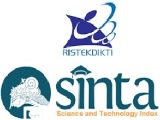PEMANFAATAN KAPUR (CaCO3) DAN LUMPUR SIDOARJO SEBAGAI BAHAN DASAR PEMBUATAN SEMEN PORTLAND
Abstract
Abstrak — Volume produk sampingan dari pabrikberupa limbah padat kalsium karbonatdan semburan lumpur Sidoarjo telah berada dalam jumlah yang kritis.Dengan volume jutaan ton ini tidak akan bermanfaat dan akan mengganggu lingkungan apabila keberadaannya tidak segera ditangani. Dalam rangka mengurangi volume lumpur dan kapur yang ada, salah satu solusi yang bisa digunakan adalah pemanfaatan lumpur Sidoarjo dan limbah kapur industri sebagai bahan dasar pembuatan semen dengan mengadopsi proses pabrik dalam skala laboratorium menggunakan briket kiln feedberbahan dasar limbah yang dibakar pada muffle furnace pada suhu 1483°C danklinker yang dihasilkan dievaluasimenurut SNI 15-2049-2004 tentang Portland Semen. Karakter fisik dan kimia dari semen berbahan dasar limbah ini menunjukkan potensi untuk menggantikan bahan dasar alam dan layak untuk diinvestasikan menjadi skala pabrik.
Kata kunci : Kapur, Lumpur Sidoarjo, Klinker, muffle furnace, Semen, Investasi.
Abstract — The volume of by-products from the factory in the form of calcium carbonate solid waste and Sidoarjo mudflow has been in critical quantities. With a volume of millions of tons this will not be beneficial and will disturb the environment if its presence is not immediately handled. In order to reduce the volume of existing mud and lime, one solution that can be used is the utilization of Sidoarjo mud and industrial lime waste as a base for making cement by adopting a laboratory-scale manufacturing process using kiln feed briquettes based on waste that is burned in muffle furnaces at 1483 ° C and linkers produced are evaluated according to SNI 15-2049-2004 concerning Portland Cement. The physical and chemical character of this waste-based cement shows the potential to replace natural raw materials and is feasible to be invested on a factory scale.
Keywords: Lime, Sidoarjo Mud, Clinker, muffle furnace, Cement, Investment.
Keywords
Full Text:
PDF (Bahasa Indonesia)References
Breizh. (2015, September Selasa). Retrieved from http://www.cheresources.com/: http://www.cheresources.com/invision/topic/21446-chemical-engineering-plant-cost-index-cepci/
Chen, H. (2015). Technical benefit and risk analysis on cement clinkering process with compact internal burning of carbon. Applied Thermal Engineering , 75, 239-247.
Ekaputri, J. J., & Triwulan. (2006). Study on Porong Mud-Based Geopolymer Concrete.
Ekaputri, J., Triwulan, S.Junaedi, Fansuri, & Aji, R. (2013). Light Weight Geopolymer Paste made with Sidoarjo Mud (Lusi). Material Science Forum , 803, 63-74.
Gresik, P. P. (2012). Sustainable Commitment in Developing Economic, Enviromental and Social Aspects. Gresik: PT. Petrokimia Gresik.
Kurdowski, W. (2014). Cement and Concrete Chemistry. Krakow,Poland: Springer.
Lea, F. (1970). The Chemistry of Cement and Concrete (3rd ed.). Glasgow: Edward Arnold (Publishers) Ltd.
Lin Yang, Y. Y. (2013). Utilization of phospate fertilizer industry waste for belite-ferroaluminate cement production. Construction and Building Materials , 38, 8-13.
Nasional, B. S. SNI 15-2049-2004 Semen Portland. BSN.
Philip A Alsop, P., Hung Chen, P., & Herman Tseng, P. (2007). The Cement Plant Operations Handbook (5th ed.). Tradeship Publications Ltd.
Pujawan, I. N. (2008). Ekonomi Teknik. In I. N. Pujawan, Ekonomi Teknik. Surabaya: Penerbit Guna Widya.
Richardson, I. (2008). The Calcium Silicate Hydrates. Cement and Concrete Research (38), 137-158.
Salah, D. B. (2010). University of Technology Iraq. Retrieved Maret Minggu, 2015, from http://www.uotechnology.edu.iq/
Singh, M., Kapur, P., & Pradip. (2008). Preparation of Calcium Sulphoaluminate Cement Using Fertilizer Plant Wastes. Journal of Hazardous Material , 157, 106-113.
Stanek, T., & Sulovsky, P. (2015). Active low-energy belite cement. Cement and Concrete Research , 203-210.
Stutzman, P. (2004). Scanning electron microscopy imaging of hydraulic cement microstructure. Cement & Concrete Composites , 957-966.
Sverak, T., Baker, C., & Kozdas, O. (2013). Efficiency of grinding stabilizers in cement clinker processing. Minerals Engineering (43-44), 52-57.
Taylor, H. F. (1990). Cement Chemistry. London: Academic Press Inc.
www.chemengonline.com. (2015, September Selasa). Chemical Engineering. Retrieved from www.chemengonline.com: https://id.scribd.com/doc/254840379/CEPCI-January-2015#download
Zajac, M., Rosberg, A., Saout, G. L., & Lothenbach, B. (2013). Influence of Limestone and Anhydrite in The Hydration of Portland Cement. Cement & Concrete Composite (46), 99-108.
DOI: http://dx.doi.org/10.30811/portal.v11i2.1528
Refbacks
- There are currently no refbacks.
Copyright (c) 2019 Vandi Alextrianto, Januarti Jaya Ekaputri






